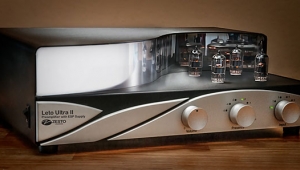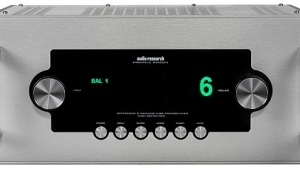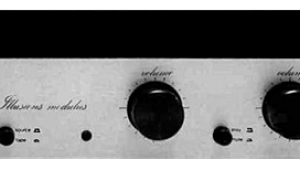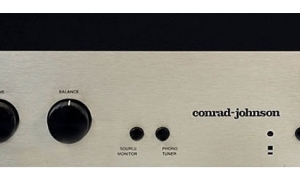| Columns Retired Columns & Blogs |
Audio Research SDP1 multichannel music processor Page 2
Here's how it works: It takes our ear/brain system about 5 to 10 milliseconds to determine the direction from which a sound reaches us. If two sounds arrive from different directions during this lock-on period, we'll hear them come from different directions; we would hear the very poor separation between the front and surround channels. After that there's a 25ms lockout period (called the "fusion zone") during which no other directional cues can be processed. If a front-coming sound is followed during the lockout period by a second sound coming from somewhere else, the second sound is masked by the first, meaning that we still hear the sound coming from the front. The effect is most pronounced with transient information and asymmetric waveforms and disappears at lower frequencies, which is why the delay keeps voices and instrumental sounds up front while the predominantly low-frequency hall reverberation seems to come from all directions.
The ideal delay time is 20ms, which is right in the middle of the fusion interval. But that's 20ms at our ears; the actual rear-channel delay that's needed will depend on the relative distances between our ears and the front and rear speakers. If both sets of speakers are the same distance from us, 20ms is the proper setting. If they're not, the delay should be adjusted according to their differences, figuring roughly 1ms/foot. For example, if your front speakers are 10' from you and the rears are 20' behind you, the rear-coming path length is 10' longer than that from the fronts, so the delay will already be 10ms. An additional 10' is all that's needed. (Most surround decoders don't provide for less than 20ms, but a total of 30ms is still within the fusion zone.) If you're 20' from the front speakers and the rears are 10' behind, the length of the rear-coming path will be 10' shorter than that of the front-coming path; the fronts rather than the surrounds will be delayed—by 10ms. In this case, a decoder delay of 30ms will do the trick.
The value used isn't critical, but it should provide a total delay at your ears of between 15 and 30ms. Substantially longer times will exceed the fusion zone, causing the surround signal to become audible as a discrete, rear-arriving echo.
The SDP1 has five delay settings ranging from 25 to 45ms, which strike me as odd choices. In fact, those settings, plus Audio Research's advice in the manual on selecting from them, seem to suggest some confusion about what the delay is supposed to be for. Twenty-five milliseconds isn't quite short enough to cope with situations where the surrounds are very close-in, as when dipoles are placed at the sides of the listening area. And to need 45ms you'd have to be sitting right in front of the surrounds, with the fronts 40' away from you. As for setting the delay, Audio Research recommends an "initial trial setting of 10 digits higher than the distance between the front and the surround speakers." Huh?
The SDP1 does not have built-in crossover networks for satellite/subwoofer speaker systems—it is apparently designed only for use with full-range speakers in all channels. This strikes me as unnecessarily restrictive, particularly since most high-end speakers are balanced to produce full, rich bass from two channels, and become bass-heavy, in my experience, when similar surround speakers are added. And satellites designed for use with a subwoofer often have limited LF-handling capability.
The sound of my system
All the electronics used for this review were loaned by Audio Research, because they wanted me to hear the SDP1 under "the best possible conditions." (While I appreciated the thought, it wasn't really necessary, because I was less concerned about how the SDP1 sounded than about how little it messed up the front channels.) The products loaned included a CDT1 CD transport, DAC3 D/A converter, a BL2 unbalanced-to-balanced input controller, an LS5 Mk.II line-stage amplifier, and two SDA1 four-channel power amplifiers. Also used were a Sony SDP-2000ES DAT recorder, a Pioneer LD-97 laserdisc player, a SOTA Cosmos turntable with vacuum hold-down, The Well Tempered Arm, an Ortofon MC-3000 cartridge and its mating step-up transformer, a Vidikron DPF40HD front projector and LD40 line-doubler, and a Stewart projection screen.
Program material included recent CD and laserdisc releases, several Classic Records/RCA LPs, and some live-performance DAT recordings (symphonic and chamber works) made locally by Steven Stone and me. Microphones used for our recordings were by Sennheiser (MKH-30 and 40), AKG (Blue-Line bodies with CK-91 capsules), and Schoeps Colettes (with MK-4 and MK-21 capsules), the last of which I purchased. The mike preamp was an Audio Engineering Associates MS380TX.
The sound of surround
My first sample SDP1 had audible hiss and a continuous whistle of maybe 3kHz in the surround channels. A second sample had a lower level of hiss, and the whistle was much quieter and was now at around 11kHz. The noise level depended on the surround level and was faintly audible during quiet program passages when the level was appropriately set.
The sound of nothing
I wasn't surprised to find the SDP1 the best-sounding surround decoder I've ever heard—or, rather, not heard. It did nothing more to the front-channel signals than what might be expected from the addition of one pair of interconnects to the system, because that's all it added electrically. There's no question here of tube sound vs solid-state sound. I could hear no "sound" from the decoder whatsoever. You might if you have a better ear for interconnects than I have, but I guarantee you won't find another surround decoder that has any less effect on the front channels than this one.
- Log in or register to post comments




































